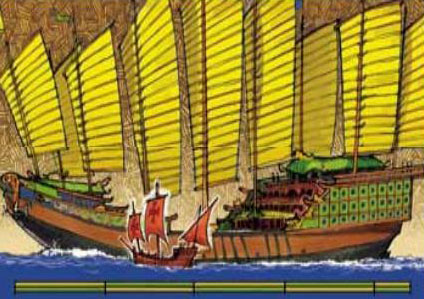"Columbus Debunker Stirs Up Chinese Whirlwind," Reuters, Oct 31, 2002
|
Zheng He ship 1405 - map
|
LONDON - Debunking Christopher Columbus has become a full-time occupation for retired British submarine commander Gavin Menzies. Next week the urbane 65-year-old begins a global publicity campaign to promote his extraordinary claim that Chinese sailors discovered America 70 years before Columbus and mapped the whole world centuries before European explorers. Despite criticism from academics that his theory is no more than "a tower of hypotheses," publisher Transworld paid 500,000 pounds ($780,000) for the rights to "1421 -- The Year China Discovered the World," a huge sum for an unknown author. A longer U.S. edition appears in January, with translations following in China, Japan, Spain and Portugal, while Britain's Pearson Broadband outbid 46 others to snap up television rights. "The extraordinary thing about it is that there is nothing new in my theory at all," Menzies told Reuters in an interview ahead of his book's November 4 publication. Menzies has stirred up a whirlwind of discovery and debate since he first detailed his theory at a London lecture in March. He now employs four researchers to handle "the torrent of information" from around the globe supporting his claim. His book expands his theory that the Chinese circled the world in fleets of vast many-masted ships between 1421 and 1423, reaching as far as America, Australia and Greenland.
WESTERN EXPLORERS
Little is known of the voyages because the fleet's records were destroyed shortly after it returned. Menzies says academics, particularly in Europe, have been blind to the possibility that someone beat Western explorers like Columbus, Magellan and Cook to the New World. "There has been a concerted effort to suppress the truth. I'm not saying it's necessarily a conspiracy. But it has served a lot of people to maintain the old status quo," he said. "There have been good livings made out of Columbus," such as debating which Caribbean island he reached in 1492. "All of that becomes much less interesting and less important if it's known that Columbus didn't discover the Americas and that he used someone else's knowledge to do so." Menzies says contemporary accounts show that all the European explorers set sail with maps of where they were going. He says these charts were copied from a now-lost master map of the world held secretly by the King of Portugal, itself derived from information brought back by the Chinese fleets. Elements of this map survive in 15th and 16th-century European maps which apparently show the Caribbean, America and Australia long before Europe reached the New World. In addition, the book draws on previously unexplained archaeological finds to support Menzies' premise that not only did Chinese sailors reach the Americas, they also settled there, influencing local culture and agriculture.
ACCOUNTS IGNORED
Menzies admits he is not the first to suggest that Columbus was beaten to the Americas, but says other accounts have been ignored. He recommends a two-volume 1990 bibliography -- "Pre-Columban Contact with the Americas Across the Ocean" -- listing hundreds of existing publications on the subject. "There is only one library in England that has got this bibliography, that's the Bodleian (at Oxford University)," he said. "It's just ridiculous." Plans are under way in China to rebuild four of the huge ships in which Chinese admirals Zheng He, Hong Bao and Zhou Man sailed, and recreate the voyages Menzies says they took by sailing them to America and Australia. There are also plans to create museums across China to celebrate the admirals, who until now had been largely forgotten even in their own country. Pearson Broadband, for a four-part documentary, will investigate a ship buried beneath California's Sacramento River to test if it is a lost junk from the Chinese fleet. Menzies says his theory could be vindicated by the discovery of a Chinese body in the Americas pre-dating the European explorers, which will be detailed in his book's U.S. edition. "It's got Chinese Jade on the throat and up its nostrils and is apparently a Chinese or Mongolian skeleton."
